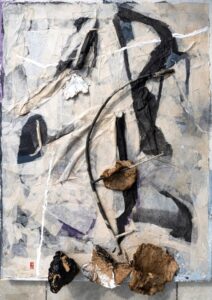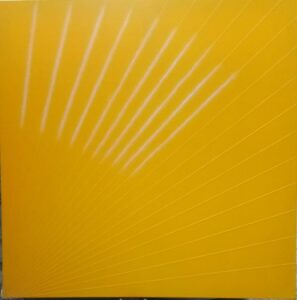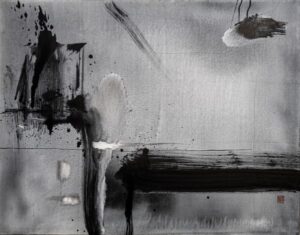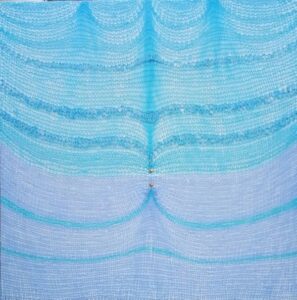Art works of Shobha Broota & Jung Hee Mun on display at Korean Cultural Centre India

Communication, mixed media on Canvas by Jung Hee Mun
Team L&M
The Korean Cultural Centre India (KCCI) is holding Spontaneous Balance, an exhibition of works by two contemporary artists Jang Hee Mun (JHM) of South Korea and India’s Shobha Broota (SB). While Broota focuses on the portrayal of order as the true essence of beauty and devotion, Mun uses a direct and pure artistic approach to the raw aspects of reality. Their works show the contrast in the diversities and the essence of the natural world.
What is your earliest memory of creating art?
JHM: I was a playful and nature-loving child, and used sticks and trees to make shapes on the sand. The earliest art piece I remember creating was a colored painting on Eden Garden when I was five. I drew a fruit tree shaped like a hand and colored it in the most vibrant and mysterious way possible.
SB: I was born in a family where the men were architects, artists and the women were busy with embroidery, stitching and cooking. So, I was introduced to a variety of mediums and was free to explore them. My memory goes back to playing around with nature in parks, gardens and ridges of Delhi. Thus, I became an intense observer and also spent time collecting and preserving leaves, flowers and insects – this habit left a deep impression on me. These visual experiences I believe with time, started translating on to paper in the form of art. In addition, learning classical music and dance gave me a sense of rhythm and helped in catching subtle nuances of sound, which I believe subconsciously instilled a unique style to my work.
Aged Anticipation by Jung Hee Mun
How do you define your art style?
JHM: I see shapes and forms through lines. They have a heavy emphasis on what I imagine, this probably is a result of the oriental style of Korean painting that I practiced. I use the traditional monochrome style of painting and portray it through layers of different forms, capturing everyday scenes. The most versatile medium for me is Ink and Hanji, which facilitates so many different properties using its fragile and versatile nature.
SB: My work is geared towards silent internal communication; hence words are not my language. All creations are born from Nothingness and lead into Nothingness. The desire to translate my intense life experiences into the empty space of a canvas is the driving force. I aspire to feel the limitlessness of the immaterial through the limits of the material.
Yellow base thread on canvas by Shobha Broota
What was the turning point in your journey with art?
JHM: The turning point was when I first came to India in 1999. I broke away from preconceptions of following the traditional method religiously. I started putting forward conscious action rather than methods.
SB: We all go through conditioning. We are taught to live in a certain way. Slowly we get bound by beautiful frills of life. We live blindly thinking this is it, but somewhere deep down, I knew this was not the true life. It’s all made up of conveniences. Once I realised this, I surrendered. I found there is another realm of existence from where life is being guided.
Homage by Jung Hee Mun
Tell us a little about your kind of art?
JHM: My art is mostly a process of spontaneous expression. It helps me become aware of myself and create a sense of comfort. Hanji is a medium that facilitates this spontaneity, it’s a very flexible and versatile material that one can use to paint, or make anything with. It allows my art to be uncertain and authentic rather than planned and pretentious.
SB: My work is an endeavour to find oneness with the universe; a search for tranquility and harmony with existence. Everything is constantly in motion and yet we aspire to a resting place. I have realised that there is a resting centre around which the cosmic existence moves, this centre is the seat of our awareness. My work is a spontaneous reflection of this realisation. And that truth of simplicity and the use of the minimum is enough to achieve the maximum.
Light blue wool on canvas by Shobha Broota
How do you strike your spontaneous balance in art?
JHM: I start with a vague idea but I rely on being guided while working by instinct. There is a state of expression where complete engagement with the process leads to a continuous flow of actions that feel satisfying and certain; that is what is meant by spontaneous balance. Spontaneity is untainted by thought. It comes when I have no expectations and am fully accepting of whatever I have done, and am about to do.
SB: I do not preconceive or prepare for the purpose of painting. It is an inner compulsion, sitting in silence before a blank canvas, I contemplate. Intuitively, I start applying pigment layer by layer, playing with the structural formation and suddenly come to realise that there is nothing more to it. The work completes by itself. Just a flicker can reveal mysteries. The process itself is self-inspiring and rejuvenating. In exploration I do not know what I will find and thus it is always a revelation. And whenever I go wrong, I take it as a blessing as it serves as motivation to change and create something new.
The show is on view till May 20 (9am to 6pm), at Nam June Paik Hall, Korean Cultural Centre India






